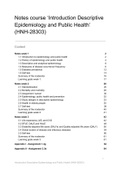Summary
Summary Notes course 'Introduction Descriptive Epidemiology and Public Health' (HNH-28303)
This is a complete summary of the course 'Introduction Descriptive Epidemiology and Public Health' (HNH-28303) of the online master Nutritional Epidemiology and Public Health.
[Show more]
Preview 4 out of 65 pages
Uploaded on
January 8, 2022
Number of pages
65
Written in
2021/2022
Type
Summary
epidemiology
public health
descriptive epidemiology
analytical epidemiology
frequency
diabetes mellitus
standardisation
mortality
morbidity
cancer
prevention
elderly people
cvd
dfle
dale
hale
dalys
le
Institution
Wageningen University (WUR)
Education
Online master - Nutritional Epidemiology and Public Health
Course
HNH-28303 Introduction Descriptive Epidemiology and Public Health (HNH28303)
All documents for this subject (1)
By: hermanvanderleeden • 8 months ago
By: harkelien • 1 year ago
$9.98
100% satisfaction guarantee
Immediately available after payment
Both online and in PDF
No strings attached




